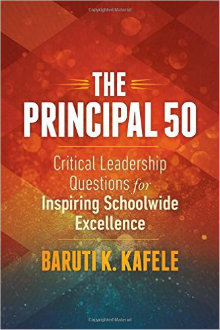A Checklist for New & Aspiring Principals
The Principal 50: Critical Leadership Questions for Inspiring Schoolwide Excellence
By Baruti K. Kafele
(ASCD, 2015 – Learn more)

The Principal 50 is written for administrators both new to their position and currently practicing as building leaders. The author, Baruti Kafele, was an elementary teacher and school principal for 20 years in New Jersey. He previously penned two ASCD best sellers, Closing the Attitude Gap and Motivating Black Males to Achieve in School and in Life. He now serves as a consultant, working with other administrators to help guide them and their schools toward success.

• The Attitude of a Leader
• School Brand
• Climate and Culture
• Building Collegial Relationships
• Instructional Leadership
• Accountability and Responsibility
• Planning, Organization, and Time Management
• Professional Development for the Leader
• Professional Development for Staff
• Parental and Community Engagement
All of the information in The Principal 50 serves to answer one overarching inquiry: “How can I inspire excellence from my entire school community?” (xii)
Questions and Answers
The questions posed by Kafele are written with the reader in mind. For example, in the first chapter on the attitude of a leader, the author asks, “Do I see myself as the number one determinant of the success or failure of my students?” (8) Kafele then responds with practical advice. Regarding this question, he believes that effective principals take responsibility for a school’s level of success. “They believe strongly that once their students arrive at school, these students belong to them – the outside world and its influences no longer matter.” (9)
Other examples of this question and answer format include, “Do I greet my students individually as they are arriving to school in the morning?” (it improves the culture and climate of the school); “Do I spend most of my time every day observing classroom instruction?” (spending time in classrooms helps ensure student learning is the focus); and “Do I and members of my staff visit schools with successful instructional programs?” (educators can’t afford to work in isolation). These brief inquiries serve as a checklist for a building principal.
Where’s the Beef?
If you are old enough, you may remember the Wendy’s commercials in which an elderly woman calls a fast food competitor and asks this question. The point of the advertisement is to suggest that Wendy’s hamburgers were more substantial than others.
As I read The Principal 50, I was wondering the same thing, at least content-wise. While I can appreciate a quick read, especially as a busy administrator, a number of the responses to the author’s own questions were sparse. Here is one example of what I am referring to (pg 46):
Q: Do I accept responsibility and accountability for both my students’ successes and failures?
A: As goes leadership, so goes the school, so you absolutely must be willing to accept responsibility for both the successes and failures of your students. Of course, it’s a lot easier to accept responsibility for the former than the latter, but shouldering blame when failures occur is the more important duty. It’s easy and convenient to blame teachers or parents for poor student performance, but acknowledging your own role is what allows you to grow in your mission. You can’t become a more effective instructional leader if you never acknowledge that improvement is possible.
It is in passages like this that Kafele seems to state the same thing over and over. Each sentence reads to me like it was reworded from the previous statement. This isn’t a criticism of the length of any one response or of the book itself. Some of the best educational resources out there, such as Peter Johnston’s Choice Words (Stenhouse, 2008), are roughly the same length but go much deeper into the topic of focus. Readers go back into these excellent texts to revisit ideas in order to apply them to practice. With The Principal 50, which I read in under an hour, I don’t see myself rereading any one passage to gain a better understanding of what was shared.
A Limited Resource for a Limited Audience
I would recommend this text for new building administrators. It would make a great gift for a principal transitioning from the classroom to the front office. In fact, I am going to mail my review copy out to a colleague who just became an assistant principal this summer. But beyond this type of audience, the lack of substance in some of the responses to the 50 questions makes it too narrow a resource for administrators in general.
Matt Renwick is a 16-year public educator who began as a 5th and 6th grade teacher in a rural school outside of Wisconsin Rapids, WI. After seven years of teaching, he served as a junior high dean of students, assistant principal and athletic director before becoming an elementary school leader in Wisconsin Rapids. Matt blogs at Reading by Example, tweets @ReadByExample and writes for EdTech magazine and other publications. His first book, Digital Student Portfolios, is available at Amazon. And his new book from ASCD/Arias on technology myths in education will be published in December.




































I appreciate you taking out the time to read The Principal 50 and review it. Yes, it is intentionally short and for that reason, couldn’t fit the additional information you would have wanted, but I appreciate you nevertheless.Thank you!
Sounds like a great read for aspiring principal